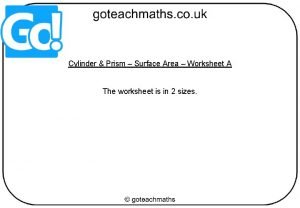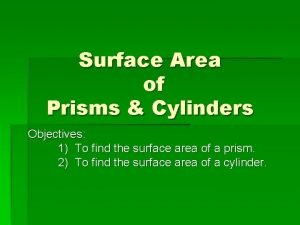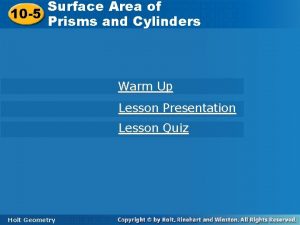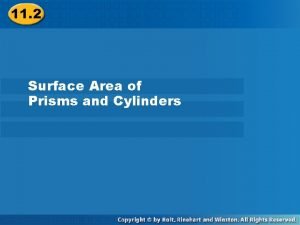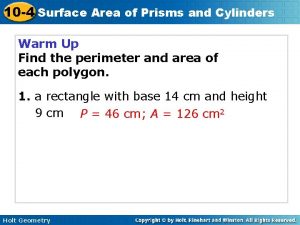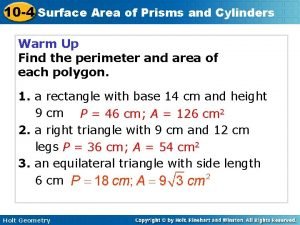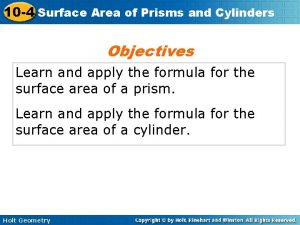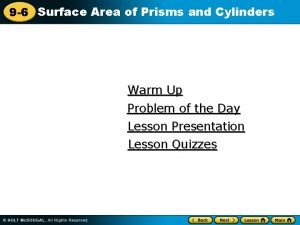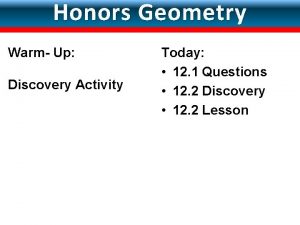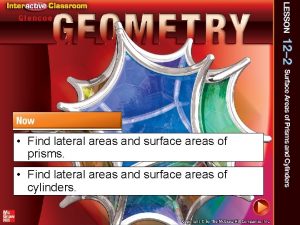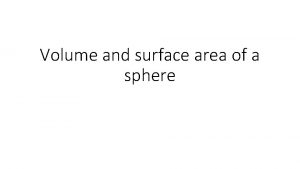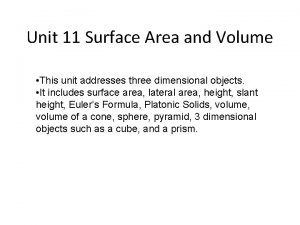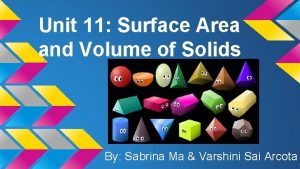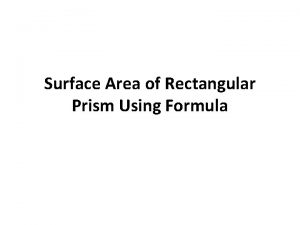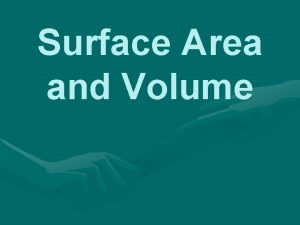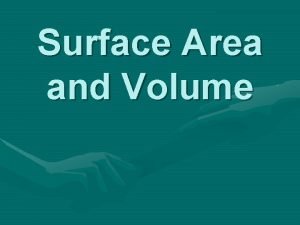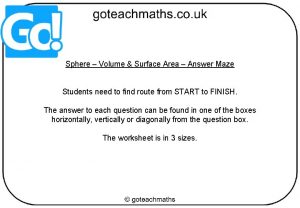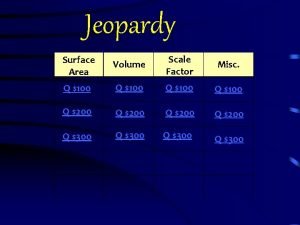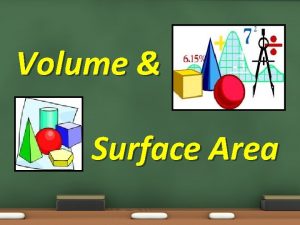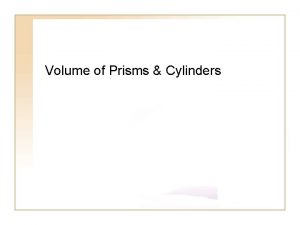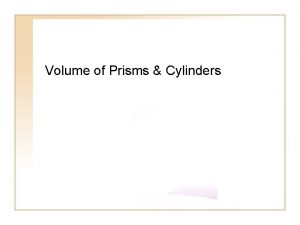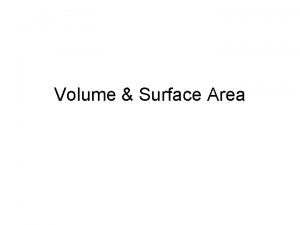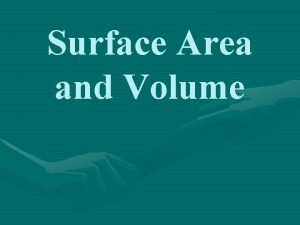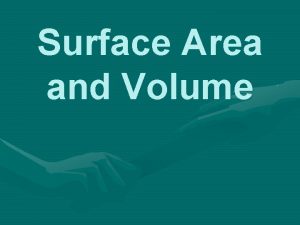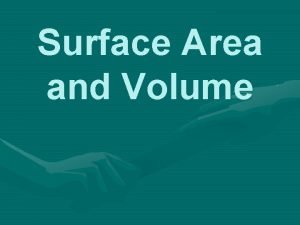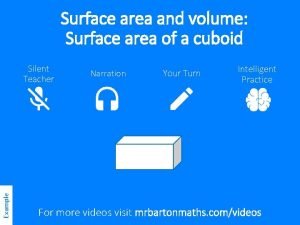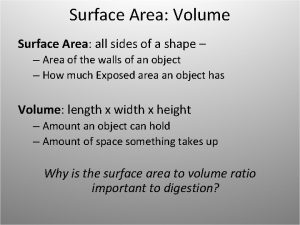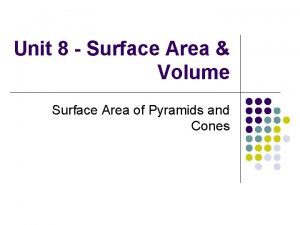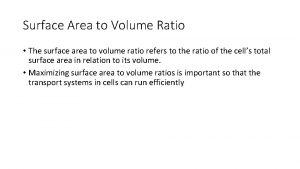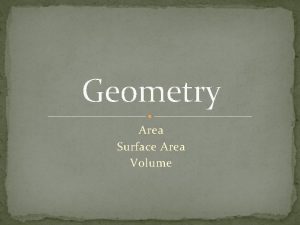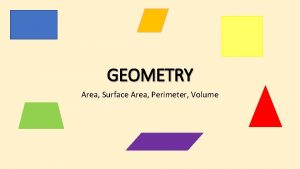Surface Area And Volume Of Cylinders Todays Learning




















- Slides: 20

Surface Area And Volume Of Cylinders

Today’s Learning Goal n n We will continue to work with flat patterns to help us see the total area of the 3 -D shape. We will continue to think about how to find the volume of different looking 3 -D objects.

Prisms n n So far, we have looked at several different prisms. Some of them are drawn below. If we continued making the top and bottom with more and more sides, what will the top and bottom eventually look like? Right…we will have 2 circles for the top and bottom.

Cylinders n n A cylinder is a 3 -dimensional shape with a top and bottom that are identical circles. There are many packages and containers that are shaped like cylinders. For example, salt, juice concentrate, soup, oatmeal, and tuna are often sold in packages shaped like cylinders.

Cylinders n n Most of you probably have made a cylinder before sometime in your childhood. Do you remember taking a piece of rectangular paper and rolling it up to make a telescope to look through? Your cylindrical telescope is made of 3 pieces: (1) a circular top, (2) an identical circular bottom, and (3) the rectangular piece of paper used to join the two circles.

Cylinders n n As with prisms, the bottom of a cylinder is called the base, and the distance from the base to the top is called the height. You can describe a cylinder by h giving its dimensions. The dimensions of a cylinder are: the radius of its base (or top) and its height. r

Cylinders n If we know the radius and n the height of a cylinder, then we can figure out its surface area and volume. 3 cm 10 cm How would we figure out the volume of the cylinder if the radius was 3 cm and the height was 10 cm? Right…figure out how many unit cubes would fit on the bottom layer and then multiply by 10 (because there would be 10 identical layers).

Cylinders How would we figure out Right…determine the area of the how many unit cubes circle. So, (3)2 28. 27 cm 3 fit could fit on the bottom in the bottom layer? n So, if 28. 27 cubic centimeters fit in the bottom layer, then 3 cm how many would fit in the entire cylinder? 10 cm Exactly… 10*28. 27 = 282. 7 cm 3 because there are 28. 27 cubes in each of 10 identical layers. n

Cylinders n The surface area of any shape is the area of all of its pieces put together. We have been drawing flat patterns to help us see the different pieces. What would the flat pattern of a cylinder look like?

Cylinders n If the radius of the cylinder was 3 cm and the height was 10 cm, then the area of the circles is (3)2 28. 27 cm 2 each. Two of them would be 2*28. 27 = 56. 54 cm 2. 28. 27 cm 2 3 cm 10 cm 28. 27 cm 2

Cylinders n To find the area of the rectangular middle, we need to know its base length and height. The height of the rectangle is the same as what dimension of the cylinder? Yes…the height 28. 27 cm 2 3 cm 10 cm 28. 27 cm 2

Cylinders n The base length of the rectangle is the same as what on the cylinder? Right…the circumference of the circle. 28. 27 cm 2 3 cm 10 cm 28. 27 cm 2

Cylinders n Who remembers the relationship between the circumference and the diameter of the circle? Yes…C = *d. So, C = (6) 18. 85 cm. 3 cm 28. 27 cm 2 18. 85 cm 10 cm 28. 27 cm 2

Cylinders n Now that we have the length and width of the rectangular piece, how do we find its area? Right…length * width. So, 18. 85 * 10 = 188. 5 cm 2 3 cm 10 cm 28. 27 cm 2 18. 85 cm 188. 5 28. 27 cm 2 10 cm

Cylinders n Now we have the area of each piece that makes up the surface of the cylinder. What is its surface area then? Yes…add up all the areas of the pieces. So, 28. 27 + 188. 5 = 245. 04 cm 2. 28. 27 cm 2 3 cm 10 cm 18. 85 cm 188. 5 28. 27 cm 2 10 cm

Partner Work n You have 20 minutes to work on the following questions with your partner.

For those that finish early 1. Often at carnivals or parties, you’ll see a game where you have to guess how many jelly beans are in a jar. Instead of just guessing randomly, suppose you counted 34 jelly beans that were on the bottom of the jar and you saw that there were about 22 jelly beans going up the height. Using our idea of volume, how could you come up with a fairly good estimate on the number of jelly beans in the jar?

Big Ideas from Today’s Lesson n n The surface area of a cylinder is determined by finding the area of the two circles (top and bottom) and the area of the rectangular piece that connects the two circles. The formula for the surface area of the cylinder is: SA = 2 r 2 + 2 rh Area of 2 circles Area of rectangular middle

Big Ideas from Today’s Lesson n n The volume of a cylinder is found the same way as a prism. We find out how many unit cubes could fit inside the bottom layer and then multiply by the number of layers. The formula for the volume of the cylinder is: V = r 2 * height # of unit cubes that can fit in bottom layer # of identical layers

Homework n Pgs. 565 – 567 (5, 7, 9, 16, 22, 29) n Pgs. 576 – 577 (5, 13, 14, 21, 22)
 Surface area of prism and cylinder worksheet
Surface area of prism and cylinder worksheet Wet curved surface area
Wet curved surface area Lateral surface area of a triangular prism formula
Lateral surface area of a triangular prism formula Area of prism
Area of prism Quiz 11-2 volume & surface area
Quiz 11-2 volume & surface area 11-2 volume of prisms and cylinders
11-2 volume of prisms and cylinders 10-4 surface area of prisms and cylinders
10-4 surface area of prisms and cylinders 10-4 surface area of prisms and cylinders
10-4 surface area of prisms and cylinders 10-4 surface area of prisms and cylinders
10-4 surface area of prisms and cylinders Surface area problem solving
Surface area problem solving 12-2 surface areas of prisms and cylinders
12-2 surface areas of prisms and cylinders Find the lateral area of the regular octagonal prism
Find the lateral area of the regular octagonal prism Area of a sphere
Area of a sphere Latwral area
Latwral area Unit 11: volume and surface area
Unit 11: volume and surface area Lateral area of rectangular prism formula
Lateral area of rectangular prism formula Prism volume and surface area
Prism volume and surface area Equation for curved surface area of a cone
Equation for curved surface area of a cone The volume of pyramid
The volume of pyramid Volume maze
Volume maze Jeopardy surface area & volume
Jeopardy surface area & volume
